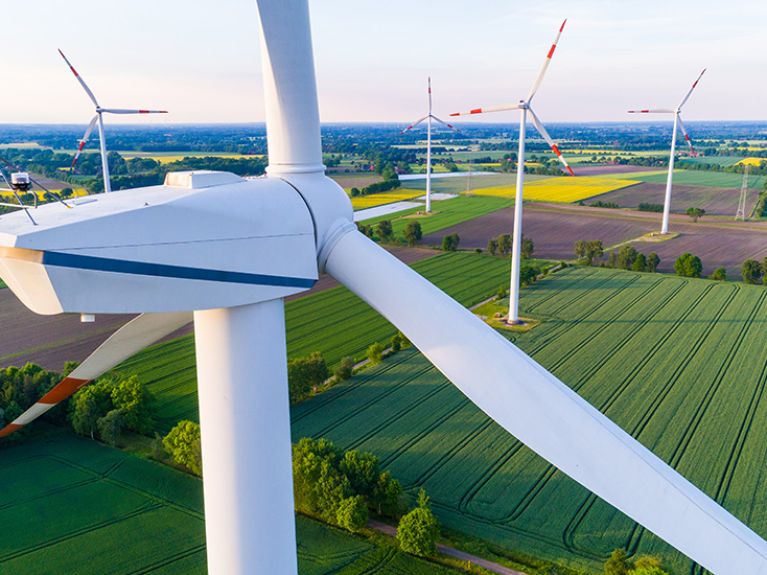The expansion of renewable energies in Germany
Where does Germany stand in the Energy Transition? We answer six questions ranging from the key goals to how consumers can contribute.

What is meant by the Energy Transition?
The term Energy Transition was originally coined more than 40 years ago, when scientists originally drafted the vision of a sustainable supply of energy: oil, coal, natural gas and nuclear energy are to be replaced with renewable energies such as wind power and photovoltaics, as well as hydroelectric power, biomass and geothermal energy. Germany has been promoting the expansion of renewables for at least 20 years – for ecological, economic and democratic reasons. The Energy Transition not only provides climate-neutral energy, thereby contributing to climate protection. It also reduces dependence on expensive energy imports, increases value creation at home and enables citizens to participate in the production of energy. When it was originally coined, as today, the term “Energy Transition” did not only include the construction of new wind turbines and solar plants. A sustainable approach to energy is also an essential component of this vision.
What support does renewable energy receive in Germany?
As early as 1990, Germany passed the world’s first so-called green electricity feed-in law, albeit with a relatively modest remuneration. This changed ten years later with the Renewable Energy Sources Act (EEG). This introduced higher subsidy rates and better terms and conditions in the electricity market. For many citizens – and for many companies, too – it was now attractive to invest in wind turbines and photovoltaic systems. Expansion accelerated, with prices falling rapidly as a result: renewables became competitive. The subsidy rates were lowered several times and finally an auction model was introduced so as to achieve the most favourable prices possible. At the beginning of 2023, the subsidy for onshore wind power was only a good seven cents per kilowatt hour; for rooftop solar systems it was around eleven cents. Many operators now even do without subsidies entirely, financing their operations directly through the electricity market.
Where does Germany stand in terms of the expansion of renewable energies?
An ever larger share of German electricity consumption is covered by renewable energies. The figure for 2022 was at least 46 percent – a new record. But the Energy Transition not only concerns the electricity supply. It includes all areas in which energy is used – i.e. mobility and the heating of buildings as well, though other terms such as transport turnaround and heat turnaround have become established, too. There is still room for improvement here.
80 percent green power by 2030 – can Germany do it?
Germany is on the right track when it comes to green power. The share of renewable energies in the electricity mix is already 46 percent, and the aim is to reach at least 80 percent by 2030. The Federal Government raised the target level in 2022 in order to meet the targets of the Paris Agreement. 65 percent was originally planned. The aim is to have converted the entire electricity system by 2035. This is feasible, but it requires things to happen much faster than is currently the case. For example, solar energy has to be added three times faster, offshore wind as much as ten times faster. But acceleration is needed at all levels – also in terms of the production of systems, the completion of approval procedures and the expansion of electricity grids. New laws have been passed to ensure this happens.
The increasing demand for electricity has also been taken into account. After all, when millions of e-cars are on the road, heat pumps have replaced old boilers and a lot of industrial processes have been electrified too, the demand for electricity is expected to increase by a third by the end of the decade. This is why the economical use of energy is a central pillar of the Energy Transition. As a rule of thumb: the less energy is consumed, the easier it will be to meet the climate targets.
How can electricity from renewable energy be stored?
A variety of storage technologies have long been available and have already been tested. In a completely renewable energy system, these ensure a secure supply during the night-time or when there is no wind, or if both these things occur at the same time and there is a sunless period of calm that lasts for days. Experts recommend an intelligent combination of different storage solutions: solar plants with battery storage, hydrogen storage, pumped storage plants, heat storage and smart grids that are able tap into e-car batteries, too. How many storage facilities will be needed in the future depends on how many wind turbines and solar plants are built – and also where. Less storage is needed in regions with a lot of wind power, while more is needed where solar plants dominate. The fundamental rule is: the less storage, the better. This is because these technologies are still expensive and a lot of energy is lost in the conversion process.
How can consumers contribute to the Energy Transition?
A lot. The most important thing is to save energy – in the use of both electrical appliances and heating. It also helps to leave the car at home and go on your bike instead, for example. Anyone who is able to have their own solar system installed on the roof or attach one to the balcony. Other tips: switch to green electricity or get involved in a citizens’ energy association that promotes renewable energies.


